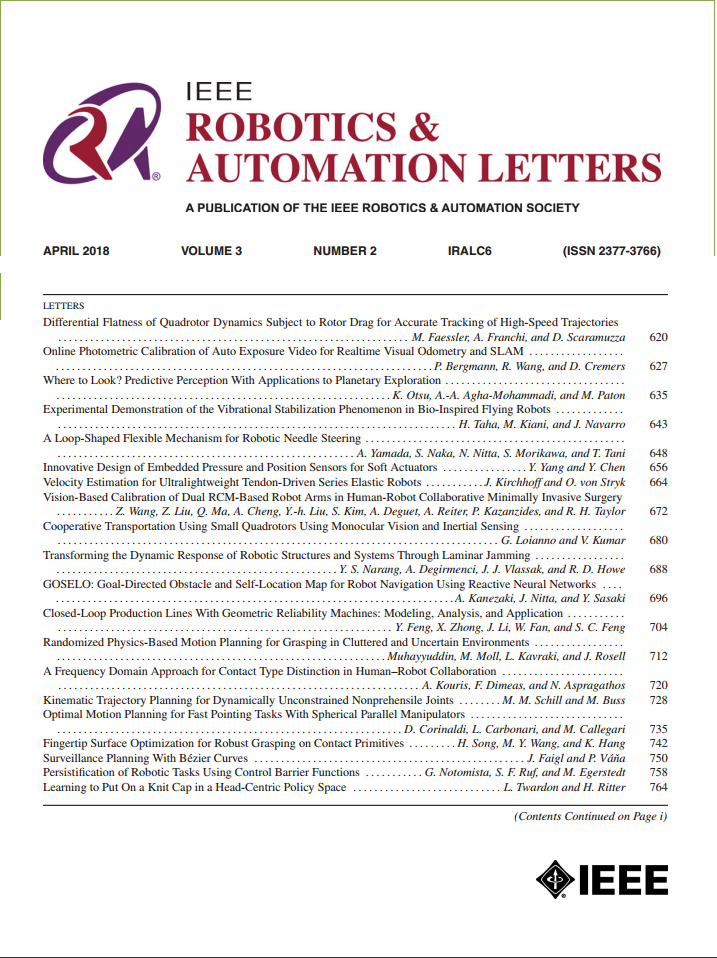应用强化学习的机器人颈动脉超声扫描的组织视图图
IF 4.6
2区 计算机科学
Q2 ROBOTICS
引用次数: 0
摘要
超声是医学上重要的诊断方式,具有成像实时、无辐射、成本低等优点。然而,超声波目前高度依赖于操作员的经验和技术技能。机器人自主超声扫描(RAUS)是一个序列决策问题,需要基于当前状态和环境的连续决策。最近,强化学习(RL)在解决各个领域的此类挑战方面取得了重大进展。然而,大多数研究直接使用原始超声图像作为端到端网络的输入。这些图像中的噪声和高维特征增加了网络的复杂性和参数的数量。在这封信中,我们提出了一种组织视图图表示,以促进机器人颈动脉扫描的无模型深度强化学习。组织视图图捕捉探针和皮肤之间的相互作用,在考虑周围组织的同时突出显示扫描对象。然后采用变分自编码器对组织视图图的特征进行编码,进一步降维。最后,我们采用近端策略优化来学习颈动脉扫描中探头调整的策略。我们的实验表明,该方法优于现有的方法,有效地处理了现实场景中的目标搜索、接触控制和图像质量优化任务。本文章由计算机程序翻译,如有差异,请以英文原文为准。
Tissue-View Map for Robotic Carotid Artery Ultrasound Scanning Using Reinforcement Learning
Ultrasound is an important diagnostic modality in medicine, offering real-time imaging, no radiation and low cost. However, ultrasound is currently highly dependent on the operator's experience and technical skills. Robotic autonomous ultrasound scanning (RAUS) is a sequential decision-making problem, requiring continuous decisions based on the current state and environment. Recently, reinforcement learning (RL) has made significant progress in solving such challenges across various domains. Nevertheless, most studies directly use raw ultrasound images as input to end-to-end networks. The noise and high-dimensional features in these images increase both network complexity and the number of parameters. In this letter, we propose a tissue-view map representation to facilitate model-free deep reinforcement learning for robotic carotid artery scanning. The tissue-view map captures the interaction between the probe and the skin, highlighting the scanned object while considering the surrounding tissues. A variational autoencoder is then employed to encode the features of the tissue-view map and further reduce dimensionality. Finally, we adopted proximal policy optimization to learn the policy for probe adjustment in carotid artery scanning. Our experiments demonstrate that the proposed method outperforms existing approaches and effectively handles the tasks of object search, contact control, and image quality optimization in real-world scenarios.
求助全文
通过发布文献求助,成功后即可免费获取论文全文。
去求助
来源期刊

IEEE Robotics and Automation Letters
Computer Science-Computer Science Applications
CiteScore
9.60
自引率
15.40%
发文量
1428
期刊介绍:
The scope of this journal is to publish peer-reviewed articles that provide a timely and concise account of innovative research ideas and application results, reporting significant theoretical findings and application case studies in areas of robotics and automation.
 求助内容:
求助内容: 应助结果提醒方式:
应助结果提醒方式:


